How Content Monitoring Can Level Up Your Content Strategy [+ Expert Tips]

I love content monitoring! Well, not as much as chocolate, or cake, or chocolate cake … But when it comes to work-related processes, it’s one of my favorite things.

Why? Because it helps me analyze what is and isn’t working. I can then use these actionable insights to create or improve upon any content strategy.
Honestly, I love content monitoring so much that I want you to love it, too.
And that‘s why I’ve included as much of my knowledge on the subject as possible in this article. I’ve also gathered more “must-know” insights from other content specialists.
On the latter, I’d like to express my gratitude upfront to everyone who shared their insights below. Seriously, dear reader, please know that when it comes to content monitoring, you’re in incredible hands. That said, let’s get into it.
Table of Contents
What is content monitoring?
Content monitoring means benchmarking and tracking content performance over time to make sure it meets key performance indicators and objectives.
You can apply a content monitoring process across digital platforms and content types. So, you might monitor how well your online content — i.e., blogs and landing pages — performs, for example.
Equally, you might track your LinkedIn content’s success or how well your email campaigns perform. You can then use the performance data to improve your content marketing strategy.
Full disclosure before we go further: My main specialism is SEO content. So, this article is very much from the perspective of monitoring online content performance. That‘s opposed to other content types like social media or email.
That’s where my expertise and the expertise of my professional network — primarily SEOs — offer the most value to you.
The Benefits of Content Monitoring
Not quite sold on why content monitoring matters? No dramas.
Below, some incredible SEO specialists and I share the key benefits of adding this process into your content marketing strategy.
Content Performance Monitoring and Benchmarking
Around 13% of marketing leaders cite content strategy as their top challenge.
I highly recommend content monitoring if this is you. It will help you overcome common strategy issues like knowing what content to produce to move the needle or what content to prioritize for “maintenance.”
As Ben Goodey, the founder of Spicy Margarita Content, says, the main benefit of content monitoring for SEOs “is to monitor the performance of content.”
Goodey explains what this can look like in practice.
“For example, closely tracking improvements/declines in keyword rankings gives a good indicator of whether you’re on the right path, need to rewrite the content, or take another path like building backlinks.”
I‘d also add that doing an initial content analysis (aka identifying what’s already working and what isn’t) as part of your monitoring will give you a benchmark to refer back to throughout your strategy.
Understanding content performance at the start and throughout can help you pivot and refine your roadmap as needed.
Clarity on Where and How to Spend Your Time
With 70% of marketers actively investing in content marketing, competition has never been fiercer. To stay competitive within your industry, you need to develop a strong content marketing strategy.
That said, there are only so many hours in a day. This means you need to know how and where to allocate your time.
Luckily, your friend and mine, Mersudin Forbes, a portfolio SEO director and agency advisor, reminds us that content monitoring can be an incredible asset here.
“If you are dealing with more than 100 pages of content, it is important to know what parts of your website need regular maintenance from a content relevance point of view,” says Forbes.
After working with large ecommerce sites, I can tell you from experience that without content monitoring in place, the overwhelming volume of data can be downright paralyzing.
Before you know it, you’re looking at 10,000 product collections, a cornucopia of blog content, and a tonne of product categories, thinking, “Where do I even start this month?”
Even if you‘re working on smaller sites, I recommend using content monitoring as part of your strategy. Long story short? You can spend your time optimizing what works and improving what doesn’t — if it makes sense to assign resources there.
But you won’t know whether an activity is worth it without some data as a starting point.
Control Over Change Frequency
Having worked in ecommerce for much of my content career, I’ve seen first-hand how quickly search demand and results can change. With each coming season, the performance of your top pages can change drastically.
One example comes to mind here: When I worked as a content manager for one site, our “Christmas rush” started in July. Call me naive, but had I not been monitoring our online content performance.
I would never have thought to trigger content updates for Christmas product collections so early in the year, or initiate content production for Christmas-themed blogs to support product collection pages.
(I know, what a sweet summer child I was!)
Seasonality changes aside, you also have to factor in search volatility as dictated by the Google Gods. Algorithm updates and AI overviews alone have caused a lot of disruption (that’s putting it mildly) in 2024.
Content monitoring allows you to identify and stay ahead of these changes.
Mersudin Forbes agrees that content monitoring is vital to controlling change frequency.
“By setting change frequency requirements up by areas of content types, assets, and priority, you can set up a system to monitor and update your content throughout the year and plan in advance of when the content could be out of date and require remedial updates.”
Content Accuracy Updates
From this control over change frequency comes another benefit: Content accuracy.
Forbes explains, “Setting up rules for what you are monitoring, why, and in what order will mean that you do not suddenly find that your capital gains tax page is referencing the wrong figures and percentages.”
As I mentioned above, you can also make sure seasonal or ‘special occasion’ content remains accurate when search demand increases at different points throughout the year.
Conversion Rate Optimization (CRO)
About 40% of marketers measure the success of their content marketing strategy based on sales. More specifically, over one in three marketing leaders use conversion rates as a top KPI that they prioritize in content tracking.
However, the average conversion rate across all ecommerce sites is just 1.8% in 2024. Meanwhile, two out of three marketers cite an average landing page conversion rate of less than 10%.
In reality, 10% is pretty good, depending on the broader context (i.e., how critical the landing page is to your service/product offering or what niche you’re in.)
Still, with many marketers across all site types looking to boost sales from their marketing efforts, CRO is critical. Content monitoring is one way to identify sales-critical pages that are underperforming.
You can then look at ways to optimize for conversions. That could be anything from improving the copy, adding testimonials as social proof, or making on-page SEO changes to improve search visibility.
Pro tip: I’m a big advocate of using Voice of Customer (VOC) data to optimize online content for conversions. Simply put, this means incorporating the language your customers and prospects actually use to describe your products, services, or surrounding topics within your online content.
For context, here’s an example of a product landing page I wrote for SKINICIAN. I’ve highlighted some of the areas inspired by VOC in yellow.
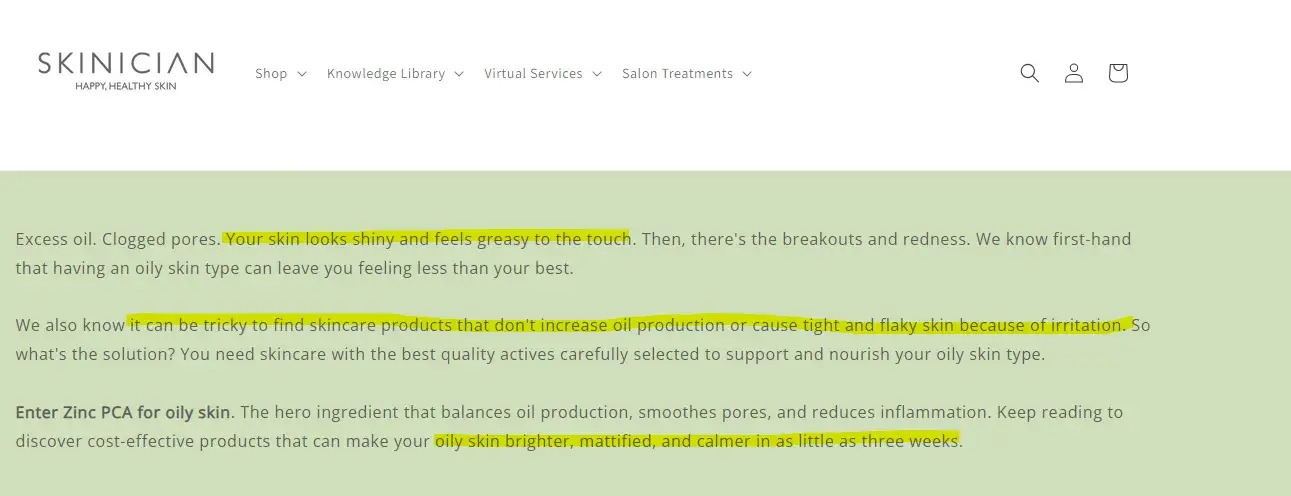
To gather VOC, consider setting up a social listening process to monitor how your audience speaks about your product or service online. You can use this language to optimize your sales landing pages for conversions.
Customer testimonials are another great source of VOC data.
How to Monitor Content
Below, I‘ve compiled an eight-step process to help you monitor content.
Even though I’ve geared this towards monitoring online content performance, many of the foundations — like setting your goals and choosing performance metrics — are similar across different content types.
So, even if you’re not in SEO, you should (hopefully!) be able to get some insights from this process. However, the specifics and examples are very much biased toward online content.
1. Choose your goals.
Before you start with your content monitoring, I recommend clarifying why you‘re doing it in the first place.
Otherwise, you’re more likely to waste time and resources monitoring the wrong content. You might choose the wrong performance metrics, too.
Further, I also suggest aligning your content goals with broader business objectives. The crux? The fruits of your labor should drive the business in the direction stakeholders want it to go.
It’s also much easier — note I say easier, not easy — to get buy-in and, thus, the all-important sign-off for strategy implementation from decision-makers when budget allocations are competitive.
Example
I recall one ecommerce project (just a heads up, I’m going to stick with this specific example throughout) where I was the content manager.
The CEO wanted us to focus on enhancing product collection performance. More specific goals within that broader goal were to increase rankings, traffic, and conversions.
A little context: We already had over 1,000 existing product collections before I took the position, so there was a fair amount of data to analyze and parse.
Because of this, we first wanted to improve and expand upon high-performing existing collections as well as those showing potential. We also wanted to create new product collections.
Based on these goals, I separated the content strategy for this project into two phases:
Existing product collection refresh/updates (capitalizing on what was already working.)
Creating new product collections (capitalizing on content gaps and potential.)
2. Define your key performance metrics to monitor online content.
When you have your goals for content monitoring, the next step is to choose your key metrics to help track content performance. These will differ depending on your desired outcome and sales funnel.
That said, recent HubSpot data highlights what marketing professionals cite as the most important web metrics to track. Sales/leads/conversion rates take the number one spot at 31%. That’s closely followed by total monthly visitors at 30% and Click-through rates at 28%.
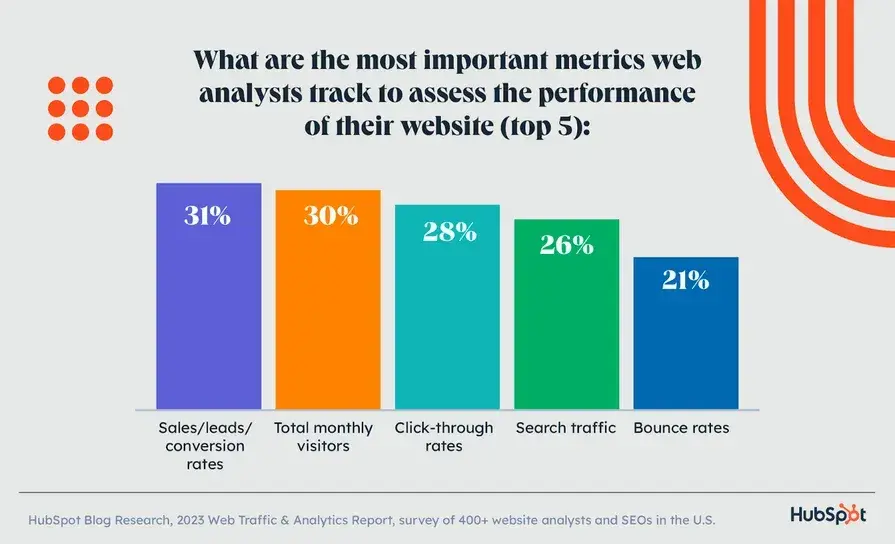
I‘m honestly not surprised by the order of importance. As marketers, we’re not sales as such, but our efforts should assist revenue when possible. But in order to have folks convert, they need to visit the site first.
So, while conversion rates will likely be your most important metric, you’ll also need to track search performance. Search performance metrics can include rankings and page hits.
Pro tip: Ben Goodey mirrors the emphasis on conversions while adding a metric you might overlook. Once your content receives traffic, he recommends monitoring metrics like conversion rate and scroll depth to help you understand the user experience of your article.
He adds, “If readers aren’t converting or scrolling far, you might need to restructure or reoptimize parts of your content.”
Example
Returning to my previous example from step 1 (choose your goals), I kept it simple when defining my metrics during the benchmarking phase.
When focusing on the “Existing product collection refresh/updates” portion of the content strategy, I needed to know what was already working and what product collections showed the most potential.
To identify this, I chose to monitor the following:
Impressions
Traffic
Clicks
Conversions
Search engine rankings
3. Benchmark existing content performance.
Once you‘ve set your goals and defined your key content metrics, it’s time to establish a benchmark for your existing content performance.
There are many ways to do this: It ultimately depends on your available tech stack, budget, and goals. I‘ll share how I achieved this in a moment.
In the meantime, I’m super stoked to provide some tool recommendations from Mersudin Forbes:
Whichever tool you choose, remember that benchmarking doesn‘t need to be complex. Content monitoring and data can be overwhelming enough as it is.
And you’re really looking for an efficient way to track existing content performance against your chosen metrics.
Example
We last left my ecommerce product collection example with my chosen content metrics. As a reminder, these were impressions, traffic, clicks, conversions, and rankings.
My first step was to establish a benchmark for content performance. To do this, I headed to Google Search Console and exported a report to Google Sheets containing all the product collection URLs in the last 12 months.
I chose a year because that time frame accounted for seasonal trends and gave a more well-rounded picture of performance.
The report included the average “Clicks,” “Impressions,” “CTR,” and “Position” of each page (aka collection URL.) I then re-ordered the spreadsheet to show the highest to lowest clicks and impressions.
I also filtered out brand and non-brand clicks.
As a rough example, here’s what this type of report looks like. This is based on an export of one of my — regretfully — abandoned personal sites *cry*:
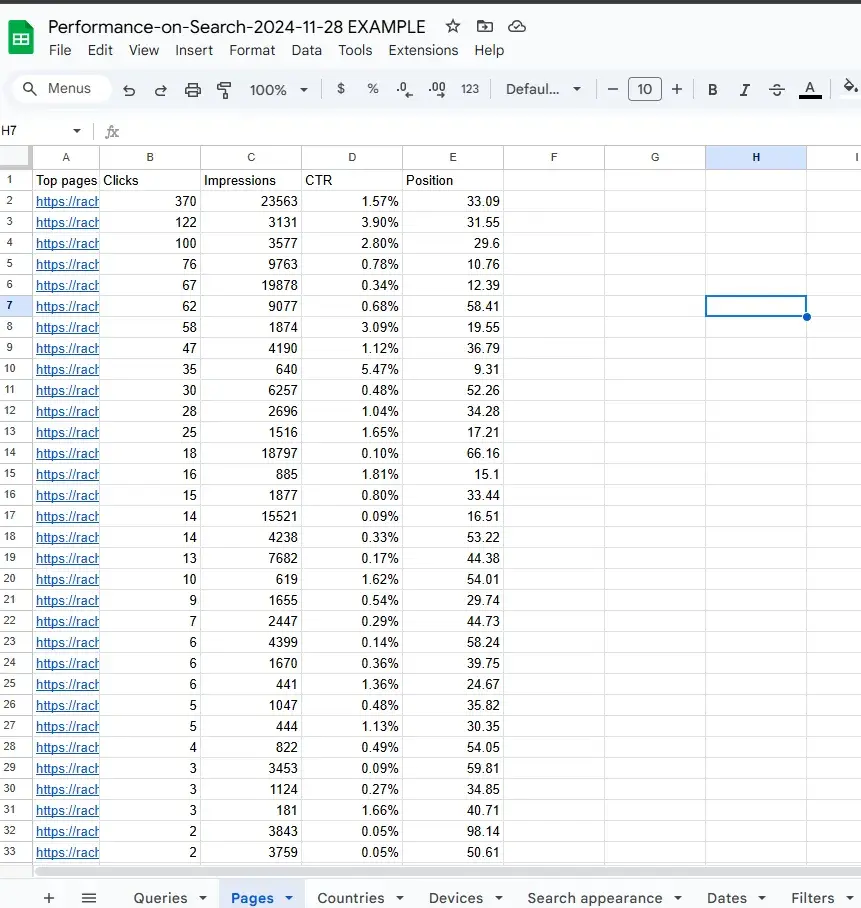
4. Prioritize content importance for monitoring.
So you have your birds-eye overview in place thanks to your monitoring process and tech stack. Huzzah! Now it’s time to prioritize content for performance monitoring.
Mersudin Forbes recommends prioritizing your cornerstone content (aka the most important pages on your website.)
“Cornerstone content should be prioritized for accuracy, relevance, and trend changes,” says Forbes. “You can set these up and plan changes ahead of time,” and you can also “set priorities up by traffic contribution and user journey importance.”
Forbes also recommends prioritizing “surfacing content performance.” To do this, you can “set up tools such as Search Console and GA4 to monitor your content performance.” He also suggests SEO Stack, which does “a great job of surfacing this for you automatically.”
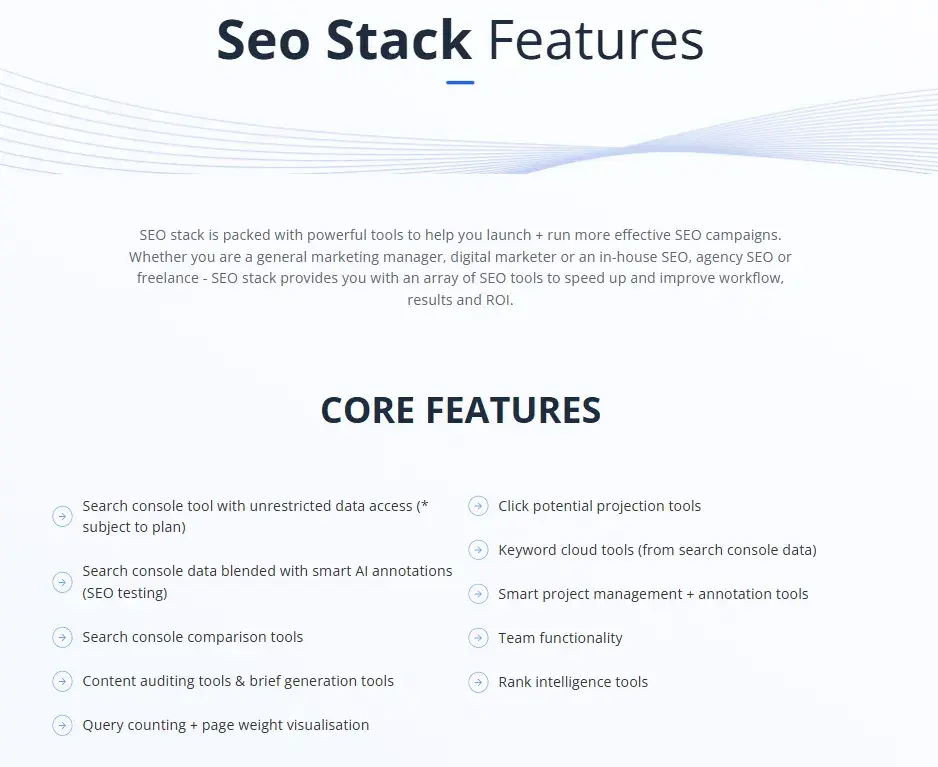
Pro tip: According to Forbes, you should monitor for declining query/traffic contribution and dwindling engagement signals. Why? Because it could show that your most important content isn’t resonating with users.
Example
Back to my example! To recap, I now had my nifty Google Sheet full of product collection URLs ordered from highest to lowest clicks and impressions.
At this stage, there hadn‘t been an organized content plan in place. Because there hadn’t been a strategy, I had to reverse engineer for both cornerstone content and content importance.
My Google sheet was ideal for this. It gave me a great initial bird’s eye view of what product collections to start working through. For context, I prioritized content updates by importance in the following way:
High impressions vs. low clicks: This indicated potential.
High impressions vs. high clicks: This highlighted existing successes we could capitalize upon — if it made sense to change the collections. (I think the adage “if it ain’t broke, don’t fix it” applies more to marketing campaigns than we’d like to admit.)
5. Set up automated alerts to monitor changes by importance.
Once you‘ve determined your most important content to monitor, you’ll want to set up automated alerts at a frequency of your choice.
Long story short? This helps you remain agile and responsive with your content strategy. For example, if rankings for a top sales-generating page suddenly tank, you’ll receive an alert. That way, you can investigate the changes and potential impact sooner rather than later.
Pro tip: Keep some balance here. You don‘t want to obsess over tracking metrics, especially when Google Core Updates can impact search volatility. In this case, rather than reacting immediately, it’s always better to wait and see if the SERPs balance themselves naturally once the update is complete.
Example
I think you can use most, if not all, of the tools already mentioned in this step-by-step process to set up content monitoring alerts for your most business-critical pages.
However, as part of my monitoring process in my ecommerce content project example, the leading automated alert I focused on was tracking SERP positions.
To do this, I used Serp Robot to monitor keyword rankings for our top collections in real time. In the next phase of the content strategy (creating new collections), I would set these alerts up for the pages with the most search potential.
6. Set up monthly content monitoring reports.
For most content projects, monthly content monitoring reports are enough.
This gives you enough time to start seeing any changes from your efforts while helping you keep that all-important balance between monitoring performance and obsessing over it.
I think this balance helps to keep you calmly responding to content issues as they arise rather than reacting to them and causing more harm than good.
In the reporting stage, you want to highlight content performance in order of importance. That means reporting on your most business-critical pages first and foremost. But you can also use these reports to identify “rising stars.”
(So, if you’ve created any new pages in the last few months that take off in terms of search performance.)
You can then map out an action plan to build upon the new page‘s success. That could be internal linking from existing pages to bolster the new page’s authority further or create new supporting content to achieve this.
Pro tip: Most SEO tools have monthly reporting options, so it‘s worth checking your existing tech stack before investing in a separate reporting tool. There are also a ton of reports you can create with Google Analytics 4 [GA4] to help you with continuous content monitoring.
(Keep ’em peeled, folks, because Zoe Ashbridge shares a few GA4 examples in the best practices section coming up soon.)
Example
When I was working on my ecommerce project, I was lucky enough to have Emma Russell, the Founder of Oxford Comma Digital, as an invaluable external resource to turn to during this stage. She set me up the most beautiful “live” Google report that also incorporated conversion tracking.
That meant that after the initial benchmarking via my Google Sheet, I could easily create monthly reports as part of my continuous content monitoring efforts. With this data, I could then analyze exactly what was happening with the product collections and identify how — or whether — to improve the most important ones.
I also knew which product collections to prioritize for continuous monitoring each month.
7. Use content performance data to inform your strategy.
Whether creating an initial benchmark to kickstart a project or monitoring a long-standing one, performance data should enhance your content strategy.
For example, if your sitewide rankings or traffic generally declines, your content tracking and reporting should highlight this. You can then analyze business-critical pages and identify potential issues.
Example
From my perspective as a content manager, one of the most important areas of improvement was the actual on-page written content for the product collections.
So I’ll speak to that.
(Although the broader team working on this project did an incredible job identifying and improving other areas, including tech fixes and removing irrelevant products!)
After prioritizing existing collections for improvement, I discovered that many had thin on-page content. As a response, I created a process for the team to identify, make, and add new relevant section text to existing collections. Based on this process, I also created a product collection template for the team.
In many cases, the descriptions of the collections were also not directly related to the products. So, for something like “pineapple decal designs,” the content was about pineapples rather than how you could use pineapple-themed decals.
Because of this, the text confused Google, and it categorized the collections incorrectly.
To avoid this happening in the future, I introduced processes and guidelines and delivered training to writers on how to use the Google Natural Language tool. We then added the Google Natural Language category and scoring as part of the content approval process.
8. Continuously improve your content monitoring process.
As key business priorities change, your content strategy will likely need to pivot.
That means specific content and even metrics, which were crucial last year, might not be insignificant this year. The knock-on effect? Your content monitoring setup will likely change.
That doesn’t mean you have to throw out the whole process. But you might find yourself reprioritizing the content and metrics you track or reevaluating the tools you use to monitor content.
You might also discover better ways to present and visualize your monthly reports, making the results clearer to non-technical stakeholders. Either way, remaining flexible where relevant to your content monitoring process is essential.
Example
The report Emma Russell constructed during my example content project was a (sorry, not sorry) “game changer.”
The fact that it showed results in real-time, rather than static results from exported data, made such a difference. It was also easier to share the data between internal departments and external resources so everyone was aligned.
Crucially, this report was something that evolved throughout the entire project. For example, we looked for more detailed ways to monitor conversions and gain user behavior insights.
Best Practices for Content Monitoring.
You‘ve heard enough from me; now it’s time to lend the mic back to some incredible SEO talent from my network.
As a heads up, I recommend referring to these best practices when building out your content monitoring process. If any tips would enhance a specific step (or steps) in the above process, I’ll highlight them throughout.
Think of content monitoring as asset management.
Note: The following best practice would be an incredible reference point for the step “choose your goals.”
Portfolio SEO director and agency advisor Mersudin Forbes suggests adopting a critical mindset throughout your content monitoring process. “Instead of monitoring content for change, think of monitoring as an asset management solution,” says Forbes.
“The same as you would look after physical properties, you would want to ensure that anything you create on your website is of high quality and following the trends of what your users require.”
He adds: “So you almost have to ask two questions: what am I monitoring for change, and what am I monitoring for no change.”
Split your site assets by seasonality, interest, and performance…
Note: The following two best practices would be an incredible reference point for the steps “benchmark existing content performance.” and “prioritize content importance for monitoring.”
In the benefits section, Mersudin Forbes mentioned identifying “which parts of your website need maintenance.” He recommends simplifying this “by splitting your site assets by seasonality, interest, and performance.”
Forbes shares the following “seasonality” examples:
Financial/budget-related content that would go out of date with new changes
Yearly industry changes in compliance
Latest reference versions of tools and products being used
Showing products by seasonality at the category level
…Then, set up key points in the year where areas of your site will need changes made.
Forbes suggests using your preferred SEO tools and processes “to get ahead of required monitoring and respective change requirements.”
As a practical way to manage these changes, he recommends going beyond a standard editorial content calendar and creating “an asset management calendar with key differentiators by content type.”
Monitor for search intent shift.
Note: The following best practice would be an incredible reference point for the steps “set up automated alerts to monitor changes by importance,” “set up monthly content monitoring reports,” and “use content performance data to inform your strategy.”
Mark Williams-Cook, the digital marketing director at Candour and founder of AlsoAsked, has previously spoken about search intent shift on LinkedIn.
I contacted him as this could be relevant to content monitoring. I’m super grateful that he was happy to share his thoughts.
“I think there’s a misconception that content stops ranking when it’s ‘old,’ when in fact, a lot of the time it’s because the intent of the search has changed and the content no longer matches it,” says Williams-Cook.
He explains that there are seasonal examples of this, such as “Halloween,” which is an informational topic for much of the year “before becoming heavy with commercial intent in October.” He also shares a longer-term example of searches related to “Covid.”
“Using AlsoAsked’s Timeline feature, we‘ve shown how searches for Covid were originally to find _what it is_ and what the symptoms were, and now many searches are more around the legal minimums of what you have to do when you have Covid.”
He adds, “We’re now with tools like ChatGPT and Screaming Frog where you can set up intent shift monitoring automatically.”
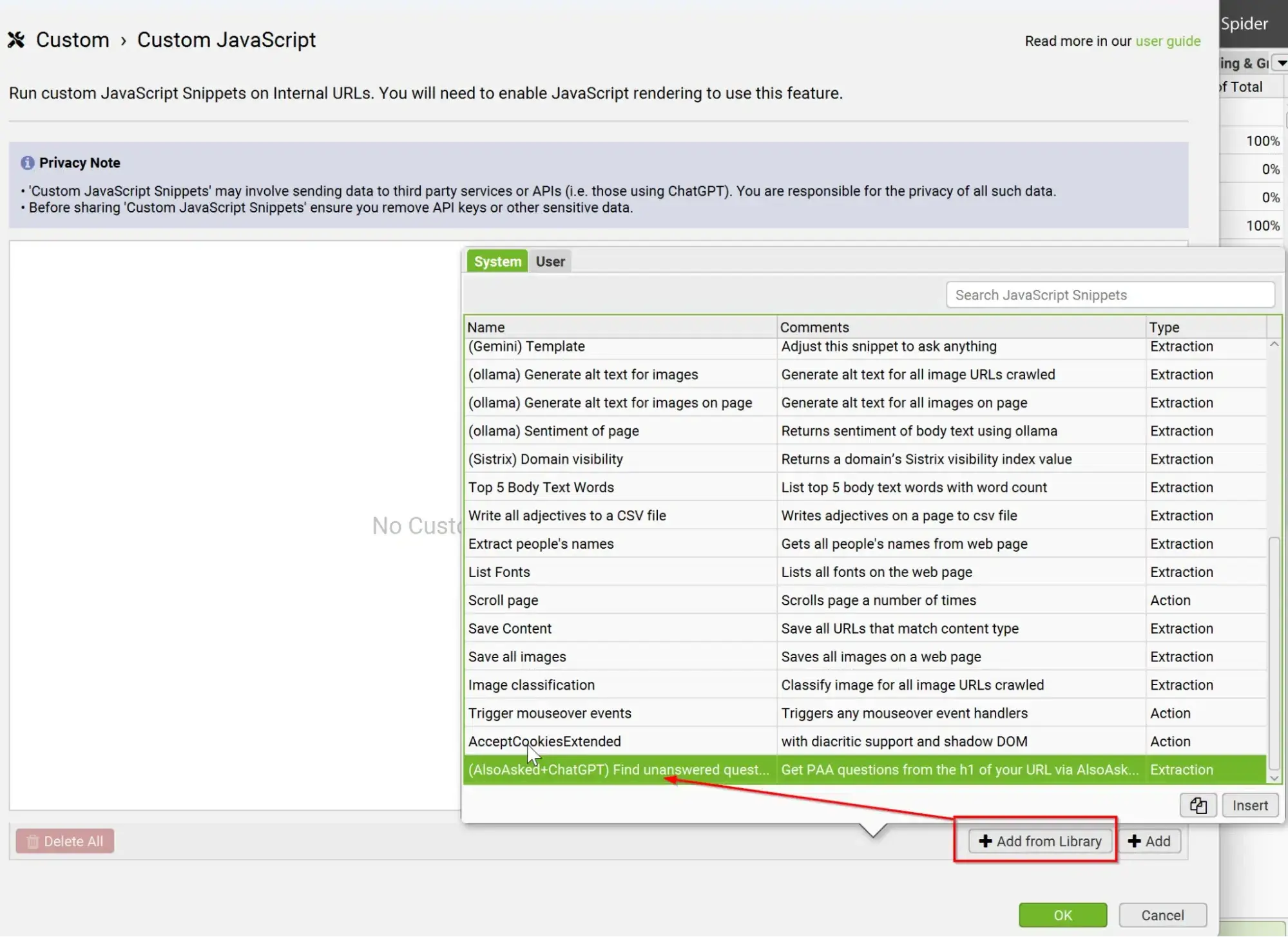
Start heat mapping and recording sessions.
Note: The following best practice would be an incredible reference point for the step “use content performance data to inform your strategy.”
Next, Ben Goodey, the founder of Spicy Margarita Content, shares a best practice related to monitoring how visitors navigate your online content.
“One best practice is to simply set up a free tool like Microsoft Clarity to start heat mapping and recording sessions,” says Goodey. “It’s incredibly insightful to watch a visitor navigate your content and will likely change how you approach content creation in the future.”
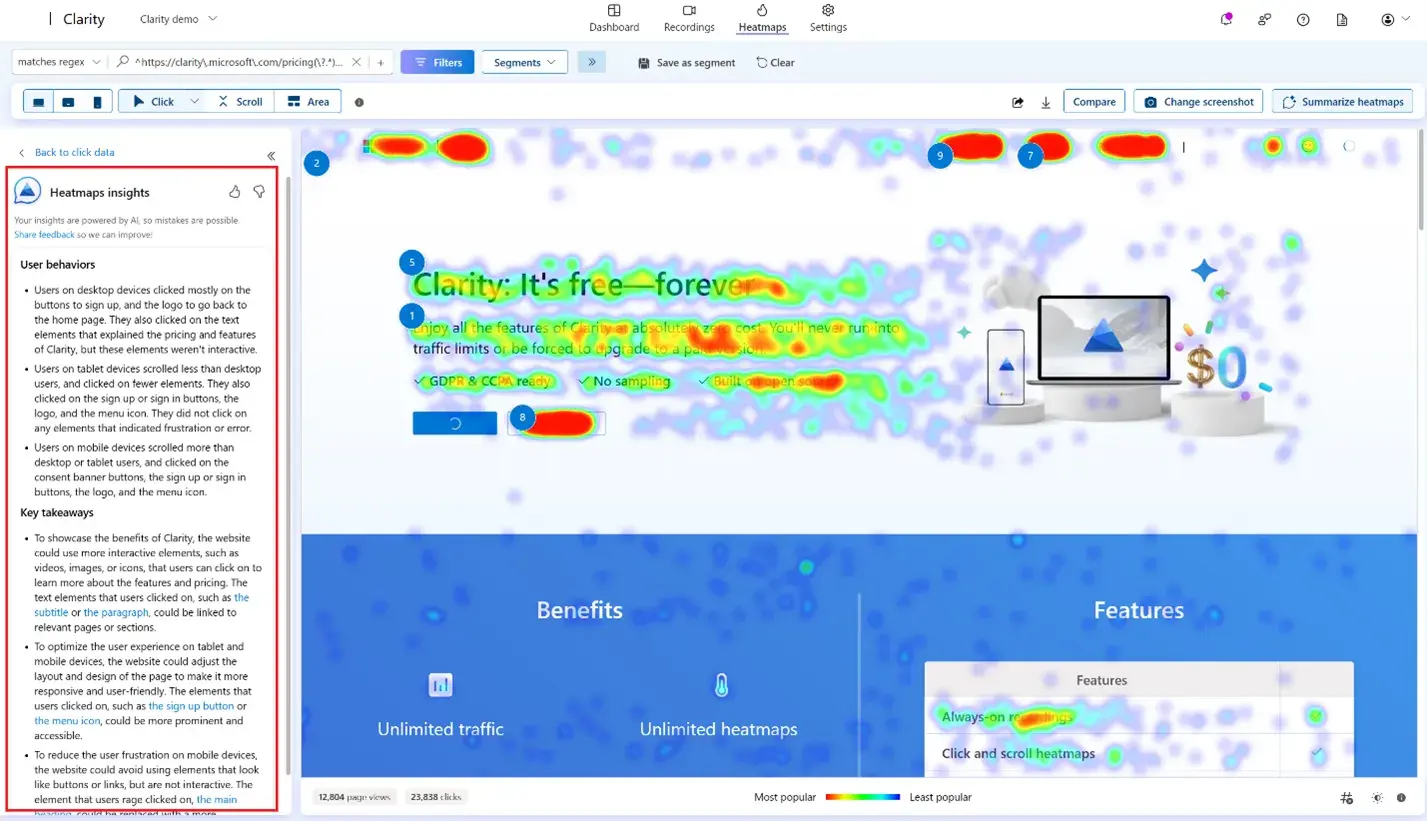
Link SEO-content performance to broader marketing and business results …
Note: The following two best practices would be incredible reference points to the steps “choose your goals,” “define your key performance metrics,” and “set up monthly content monitoring reports.”
Earlier this year, I was privileged to help craft HubSpot’s Ultimate Guide to SEO.
No mean feat, let me tell you.
In the article, I shared a series of SEO best practices from some incredible leaders in our industry. Zoe Ashbridge, the senior SEO strategist and co-founder at forank (who also writes for HubSpot!), shared some insights regarding metrics and tracking that are worth revisiting in this piece.
Ashbridge discussed the importance of linking SEO results to broader marketing and business results. To top it off, she also shared some metrics and reports she uses to achieve this.
“It’s true that tracking SEO success can be difficult. Unlike PPC, you can’t point to a conversion and know exactly which search term drove it. However, there is a lot you can track,” says Ashbridge.
She adds: “Tracking SEO’s efforts does require some awareness of marketing and how it works holistically. Although tracking SEO’s efforts is an imperfect system, it’s better than the alternative: blind faith!”
… By using the following specific metrics and reports.
Ashbridge reminds us that the metrics you use to monitor online content depend on your sales funnel. That said, there are some metrics she recommends using to monitor SEO success:
Clicks and Impressions; Separate Brand and Non-Brand Clicks. “This is very important. While SEO can do a lot with brand search, its primary role is bringing new users to the site through top and middle funnel content.”
Performance of Pages Built for SEO That Don’t Pull In a Lot of Brand Search. You can do this by tracking “Revenue or conversions direct from pages created at SEO’s request” using GA4’s landing page report.
Track Sales or Conversions From Users Who Also Viewed Content. To do this, Ashbridge uses GA4’s segment overlap.
Organic Revenue Sitewide. This is especially critical for ecommerce.
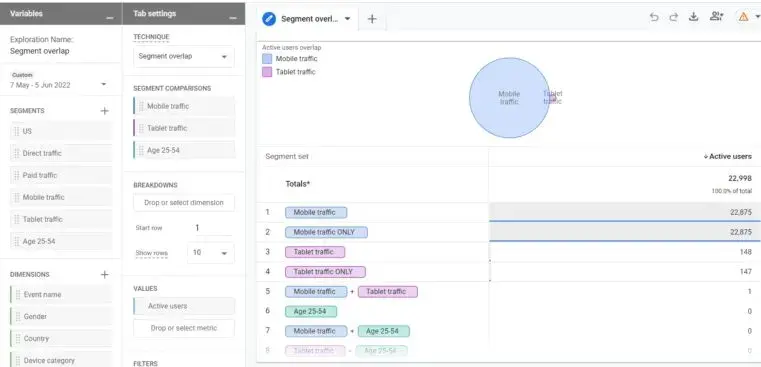
If you’re a service-based business, Ashbridge suggests also tracking your leads internally. “The goal is to credit SEO for its sales assists,” says Ashbridge.
“If SEO brings traffic to the site, your retargeting campaign and email marketing might convert them. You can identify content that’s part of the buyer journey with the [GA4] segment overlap.”
Content Monitoring: The Real ‘Hack’ Is To Keep Learning
I hope you’ve learned a ton throughout this article — if not from my insights, from those shared by content leaders in our industry.
On the latter, I’ve been in this marketing game for a fair few years, and I picked up so much new knowledge from everyone who contributed to this piece.
I’m kind of embarrassed to say I’ve never considered heat mapping as part of my content monitoring process. I will definitely take that with me as I monitor online content in the future.
And I love the suggestion of thinking about content monitoring as “asset management” and incorporating this approach into your editorial calendar.
Further, I picked up some incredible tips about reporting with GA4, which, as you know, if you’re in SEO, has been the bane of many a specialist’s life since the sunsetting of Universal Analytics in 2024.
Suffice it to say that there are tips, tricks, and hacks a plenty when it comes to content monitoring. That said, as with many areas of SEO and marketing, the actual hack is to keep an open mind. Because the learning? Well, it never ends.




